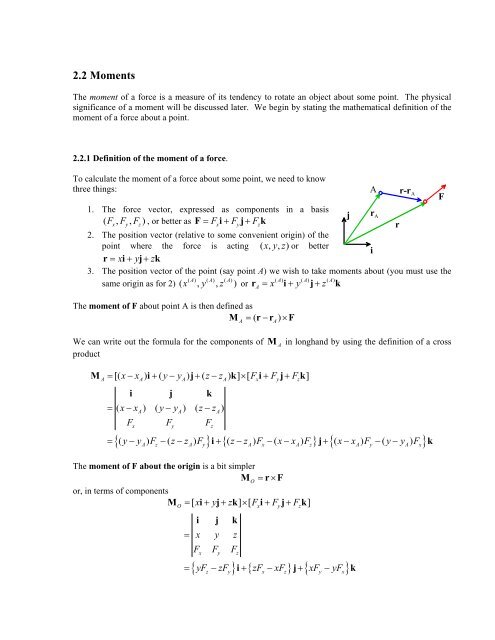Chapter 2 Review of Forces and Moments - Brown University
Chapter 2 Review of Forces and Moments - Brown University
Chapter 2 Review of Forces and Moments - Brown University
You also want an ePaper? Increase the reach of your titles
YUMPU automatically turns print PDFs into web optimized ePapers that Google loves.
2.2 <strong>Moments</strong><br />
The moment <strong>of</strong> a force is a measure <strong>of</strong> its tendency to rotate an object about some point. The physical<br />
significance <strong>of</strong> a moment will be discussed later. We begin by stating the mathematical definition <strong>of</strong> the<br />
moment <strong>of</strong> a force about a point.<br />
2.2.1 Definition <strong>of</strong> the moment <strong>of</strong> a force.<br />
To calculate the moment <strong>of</strong> a force about some point, we need to know<br />
three things:<br />
A r-r A<br />
F<br />
1. The force vector, expressed as components in a basis<br />
j r A<br />
( Fx , Fy, F<br />
z)<br />
, or better as F= Fxi+ Fyj + Fzk<br />
r<br />
2. The position vector (relative to some convenient origin) <strong>of</strong> the<br />
point where the force is acting ( x, yz , ) or better<br />
r = xi+ yj+<br />
zk<br />
i<br />
3. The position vector <strong>of</strong> the point (say point A) we wish to take moments about (you must use the<br />
( A) ( A) ( A)<br />
( A) ( A) ( A)<br />
same origin as for 2) ( x , y , z ) or rA = x i+ y j+<br />
z k<br />
The moment <strong>of</strong> F about point A is then defined as<br />
M = ( r− r ) × F<br />
We can write out the formula for the components <strong>of</strong><br />
product<br />
M = [( x− x ) i+ ( y− y ) j+ ( z− z ) k] × [ Fi+ F j+<br />
Fk]<br />
A A A A x y z<br />
i j k<br />
= ( x−xA) ( y− yA) ( z−zA)<br />
F F F<br />
x y z<br />
A<br />
A<br />
M<br />
A<br />
in longh<strong>and</strong> by using the definition <strong>of</strong> a cross<br />
{( y yA) Fz ( z zA) Fy} {( z zA) Fx ( x xA) Fz} {( x xA) Fy ( y yA)<br />
Fx}<br />
= − − − i + − − − j+ − − − k<br />
The moment <strong>of</strong> F about the origin is a bit simpler<br />
MO = r×<br />
F<br />
or, in terms <strong>of</strong> components<br />
M = [ xi+ yj+ zk] × [ Fi+ F j+<br />
Fk]<br />
O x y z<br />
i j k<br />
= x y z<br />
F F F<br />
x y z<br />
{ yFz zFy} { zFx xFz} { xFy yFx}<br />
= − i + − j+ − k
















